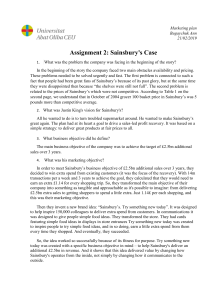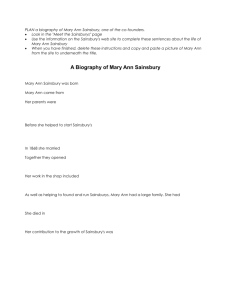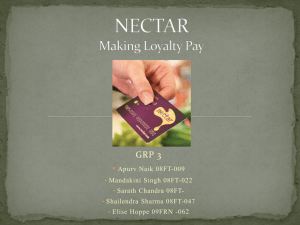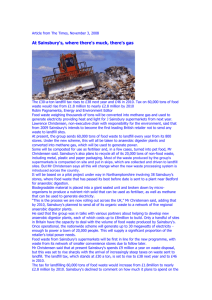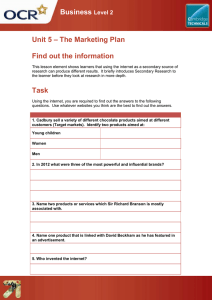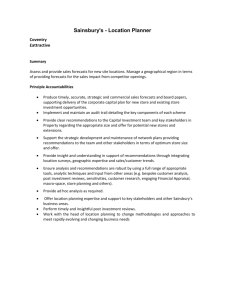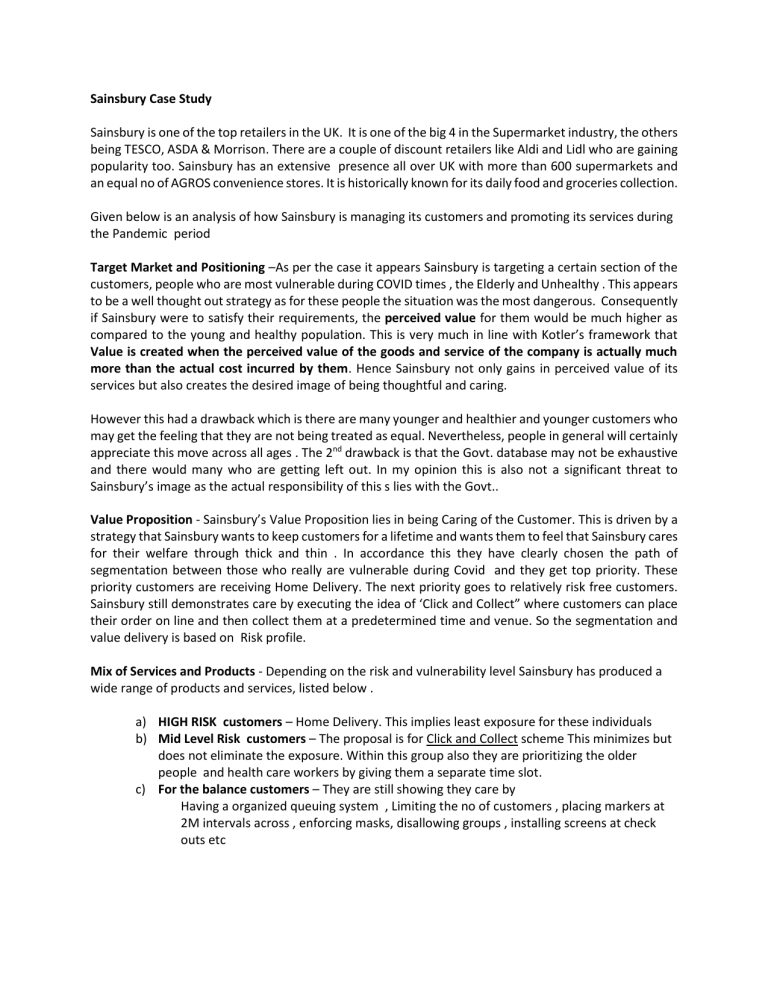
Sainsbury Case Study Sainsbury is one of the top retailers in the UK. It is one of the big 4 in the Supermarket industry, the others being TESCO, ASDA & Morrison. There are a couple of discount retailers like Aldi and Lidl who are gaining popularity too. Sainsbury has an extensive presence all over UK with more than 600 supermarkets and an equal no of AGROS convenience stores. It is historically known for its daily food and groceries collection. Given below is an analysis of how Sainsbury is managing its customers and promoting its services during the Pandemic period Target Market and Positioning –As per the case it appears Sainsbury is targeting a certain section of the customers, people who are most vulnerable during COVID times , the Elderly and Unhealthy . This appears to be a well thought out strategy as for these people the situation was the most dangerous. Consequently if Sainsbury were to satisfy their requirements, the perceived value for them would be much higher as compared to the young and healthy population. This is very much in line with Kotler’s framework that Value is created when the perceived value of the goods and service of the company is actually much more than the actual cost incurred by them. Hence Sainsbury not only gains in perceived value of its services but also creates the desired image of being thoughtful and caring. However this had a drawback which is there are many younger and healthier and younger customers who may get the feeling that they are not being treated as equal. Nevertheless, people in general will certainly appreciate this move across all ages . The 2nd drawback is that the Govt. database may not be exhaustive and there would many who are getting left out. In my opinion this is also not a significant threat to Sainsbury’s image as the actual responsibility of this s lies with the Govt.. Value Proposition - Sainsbury’s Value Proposition lies in being Caring of the Customer. This is driven by a strategy that Sainsbury wants to keep customers for a lifetime and wants them to feel that Sainsbury cares for their welfare through thick and thin . In accordance this they have clearly chosen the path of segmentation between those who really are vulnerable during Covid and they get top priority. These priority customers are receiving Home Delivery. The next priority goes to relatively risk free customers. Sainsbury still demonstrates care by executing the idea of ‘Click and Collect” where customers can place their order on line and then collect them at a predetermined time and venue. So the segmentation and value delivery is based on Risk profile. Mix of Services and Products - Depending on the risk and vulnerability level Sainsbury has produced a wide range of products and services, listed below . a) HIGH RISK customers – Home Delivery. This implies least exposure for these individuals b) Mid Level Risk customers – The proposal is for Click and Collect scheme This minimizes but does not eliminate the exposure. Within this group also they are prioritizing the older people and health care workers by giving them a separate time slot. c) For the balance customers – They are still showing they care by Having a organized queuing system , Limiting the no of customers , placing markers at 2M intervals across , enforcing masks, disallowing groups , installing screens at check outs etc d) Marketing Communications – In these unprecedented times, one should focus on constant communication to show what all Sainsbury is doing to protect the customer’s health. In fact , the Top management has been communicating regularly through various channels to their customers and this should assuage the customers that they are safe e) Pricing – Sainsbury is in the mid segment ‘Value for Money’ strategy which implies Selling good quality products at a reasonable price. It avoids discounting its prices too much as it is not only unprofitable but may lead to having only fair weathered customers. The goal is to have “True friends” and avoid the ‘’ Barnacles ‘and “Butterflies” f) Channels – As mentioned earlier they have now 3 channels of delivery as per the associated risk and vulnerability -Home Delivery for the high risk customer at no risk -Click and Collect for the lower risk customers. They will collect their ordered goods at designated areas and time so that exposure is minimal. For the rest customers have to visit the store , although they are taking adequate precautions to ensure minimal social exposure. Additionally sanitization mechanisms are also available in store. From their website its gathered Sainsbury has smaller Stand Alone cum stores called Agros . which is mostly shut down now . Smartly they’ve reallocated their staff to strengthen their Online Delivery Process from their main stores. A brilliant idea to maximize Customer Value. QUESTION 2 In my opinion Sainsbury has its marketing strategy & communication based on CARE and LIVE WELL with LESS and has also tried to demonstrate to the customers consistently on these . People who have benefitted from their various products and services ie. Sainsbury’s Home Delivery, Click and Collect as well as the In store Precautions are likely to appreciate these gestures from Sainsbury. Overall as per Case study that the TARGET for Sainsbury is the Vulnerable Customers and many of their communication and POSITIONING is built around this SEGMENT on priority over the other SEGMENTS which are Fit n Healthy and Moderate Risk profilers However there are a couple of areas of improvements, which are a) Customer relationship Management Some of the customers got let out as they did not feature in the govt. data base as vulnerable. If Sainsbury can figure out a way for identifying these customers and start offering them a special scheme, they will be delighted & remain loyal . Also there were situations when customers had to stand in queue for long hours at the beginning of the pandemic. Its proposed that Sainsbury issues an apologetic communication about this initial experience and emphasize measures that they have taken to reduce this inconvenience. b) Customer Loyalty – In my opinion, this could be an appropriate time to offer even more discounts/offers to Sainsbury customers holding loyalty cards. This should reinforce the feelings among regular customers that Sainsbury cares and incentivize them to continue for a long timein the future . Also, this would improve the perceived value of the Loyalty cards and should result in more n more people applying for that card. - One could also tie up the various healthcare institutions where Loyalty card holders are given a special status and priority. SPONSORSHIPS - It is recommended that Sponsorships of Health Care and Well ness activities would be in sync with their Brand Slogan of “Live Well with Less” positioning statement c) Interactive Relationships – This is also the right occasion to encourage participation form customers on their Social media platform. In fact the SM platforms should become super active now with constant posts. These could be tips about how to effectively spend time during lockdown and should cover a wide range of activities (culinary, fitness, reading, online games, online quizzes and various contests) . d) Consumer Managed Relationship – If the above initiatives go well Sainsbury should actually try shifting to this stage too where Customers suggest recipes/ fitness tips/ other ideas to live through Covid times and the best ideas are rewarded handsomely with high profile visibility. In fact the effort should be try to ensure people throng Sainsbury website and chances are they will buy more n more online e) Partner Relationship Management – To show their gratitude to their suppliers and other business partners Sainsbury can also offer a) Special discount coupons for them b) Allot special time slots where the partners can avail of the ‘Clock and Collect’ scheme f) Pricing - Since Sainsbury is a old and trusted brand, one would advise it to stay away from discounting strategies . Assuming most of the customers have been loyal to Sainsbury from its earlier days they should build upon this loyalty and essentially improve its loyalty based facilities. This should prevent more value conscious customers from switching to other stores. g) Cross Selling – This should also be an appropriate time for Sainsbury to try and cross sell health related products, which may not get priority during normal times. So indoor health and exercise equipment or Over the Counter Medicines can be given a place of prominence in their stores. h) Space Utilization – If one assumes that Sainsbury with its long history has good quality, prime retail space some additional focus on this area should pay dividends. So health n wellness related products should be accommodated more n more within the space. Ideally Sainsbury should collect continuous feedback from its customers and Loyalty Cards to focus on the new product ideas ( in the same space) CONCLUSION – In my opinion Sainsbury with their “Live WELL for LESS” slogan is in an advantageous situation now to regain customer loyalty and recover share in UK . All the strategies and actions discussed above can be woven around this theme . It also has the added advantage of being a long standing and trusted name in the British market and the loyalty theme should pay maximum dividends . So it is recommended that Sainsbury focusses all out on customer loyalty activities which is the best way to generate Customer Equity References www.sainsbury.co.uk – Brand Slogan , Annual Reports , Chairman and CEO’s letter , Suppliers , About Us , Corporate Social Responsibility , etc For Q1 reference was Principle of Marketing: Philip Kotler Sections & Sub Sections considered for Customer Value Module related question are Designing a Customer Value Driven Marketing Strategy Selecting a Customer to Serve Choosing a Value Proposition Marketing Management Operations Building Customer Relationships Customer Relationship Management Engaging Customers Partner Relationship Management Creating Customer Loyalty and Retention Growing Share of Customer Building Customer Equity
